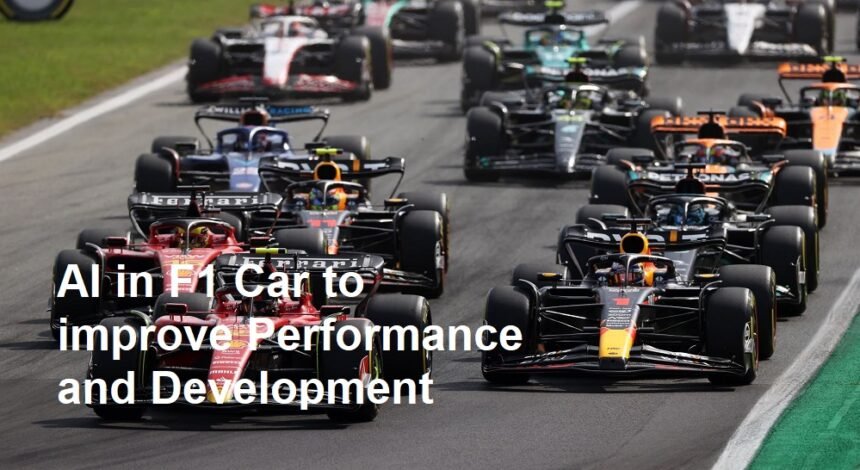Formula 1 (F1), the pinnacle of motorsport, is a sport that thrives on speed, precision, and innovation. Over the years, F1 has continuously pushed the boundaries of technology to enhance performance and drive the sport into the future. One of the most exciting technological advancements in recent years is the integration of Artificial Intelligence (AI) into various aspects of the sport. From optimizing car performance to improving race strategies and enhancing fan experiences, AI is becoming an indispensable tool in Formula 1. This article explores how AI is being utilized in F1 and its potential to shape the future of motorsports.
Formula 1 and the Integration of AI: Revolutionizing the World of Motorsports
One of the most significant ways AI is making its mark in Formula 1 is through car performance and development. F1 teams are known for their relentless pursuit of optimization, seeking to make every aspect of the car as efficient and fast as possible. In this highly competitive environment, even the smallest advantage can make the difference between victory and defeat.
AI plays a key role in car design and aerodynamics. Using machine learning algorithms, teams can analyze vast amounts of data from wind tunnels, simulations, and real-world testing. AI helps optimize the car’s aerodynamics by predicting airflow patterns and improving the design of components such as the front and rear wings. These algorithms can simulate thousands of design variations, allowing teams to choose the most efficient configurations without needing to conduct physical tests for every possible change, saving both time and resources.
Additionally, AI is being used to fine-tune the car’s setup for each race. By analyzing past performance data, AI can suggest adjustments to the suspension, tire pressure, and other settings that could improve performance on specific circuits. This level of precision is crucial, as track conditions, weather, and tire wear can vary significantly from race to race. AI algorithms can quickly process historical data and predict the optimal setup for a particular race, ensuring the car is fine-tuned for the best possible performance.
Race strategy is another area where AI is making a significant impact. Formula 1 races are often won or lost based on the team’s ability to make split-second decisions. AI systems are now used to process real-time data during races, allowing teams to make informed strategic choices on everything from tire changes to pit stop timing.
AI algorithms analyze a variety of data points during a race, including car performance, tire degradation, weather conditions, and competitor strategies. This data is then used to create simulations that predict how different strategies will play out throughout the race. For example, AI can help teams decide the optimal time for a pit stop or determine whether a tire change is necessary to maintain competitive lap times.
One of the most powerful applications of AI in race strategy is predictive modeling. By processing historical race data and considering current conditions, AI can predict how the race might unfold, enabling teams to make proactive decisions. This can be crucial when dealing with unpredictable elements, such as accidents or changes in weather. The ability to anticipate various race scenarios gives teams a significant strategic advantage, allowing them to react quickly and adjust their plans on the fly.
In addition to improving car performance and race strategy, AI is also being used to enhance driver performance. F1 drivers are some of the most skilled athletes in the world, and every advantage, whether technological or psychological, can make a difference in their performance on the track.
AI-driven systems analyze a driver’s performance by tracking data such as lap times, cornering speeds, braking patterns, and throttle control. These systems can provide drivers with valuable feedback in real-time, helping them fine-tune their driving style for optimal results. For example, AI can suggest braking points, throttle applications, or steering inputs that could lead to faster lap times based on historical data and machine learning algorithms.
AI can also help drivers improve their mental and physical preparation. AI-powered simulators allow drivers to practice on virtual versions of tracks, providing them with a highly realistic training experience. These simulators are often used to familiarize drivers with new circuits or to practice race scenarios that may not be easily replicated in real life. Through the use of AI, drivers can gain insights into their strengths and weaknesses, allowing them to focus on areas that need improvement.
AI is also transforming the fan experience, creating new ways for audiences to engage with Formula 1. With the rise of digital platforms and social media, fans expect more personalized and interactive content. AI has enabled F1 to meet these demands by providing real-time race analysis, insights, and even virtual experiences.
One notable development is the use of AI to enhance broadcast coverage. During live races, AI can analyze data and provide commentators with insights about the race that might not be immediately apparent to viewers. For example, AI can track a driver’s tire wear, predict the effect of weather changes, or highlight key moments in the race. These insights enrich the viewing experience, providing fans with a deeper understanding of the race dynamics.
Additionally, AI has been used to create virtual race simulations and highlight reels. Fans can interact with these simulations, exploring different race scenarios and outcomes based on different strategies. This type of content allows fans to engage with the sport in a more immersive and personalized way, enhancing their connection to the races and drivers.
The Future of AI in F1, As technology continues to evolve, the role of AI in Formula 1 is expected to grow even further. The integration of AI into car design, race strategy, driver performance, and fan engagement is just the beginning. In the future, we may see even more advanced applications, such as fully autonomous racing or AI-powered coaching for drivers.
While the implementation of AI has the potential to revolutionize the sport, it also raises questions about the balance between human skill and technology. As AI takes on more responsibilities in the design and strategy of races, there may be concerns about the human element in motorsports. However, many see AI as a tool that can enhance human performance rather than replace it.













